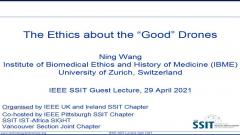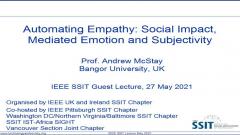This SSIT Distinguished Lecture by Prof. Clinton Andrews (Rutgers University, US) was presented at a Joint Chapter Meeting organised by IEEE UK and Ireland SSIT Chapter and co-hosted by Santa Clara Valley SSIT Chapter, Washington, D/Northern Virginia/Baltimore SSIT Chapter, Pittsburgh SSIT Chapter and SSIT IST-Africa SIGHT on 11 March 2021.
Focus
Not since the era of the family farm has such a large fraction of the employed population worked from home. The spike in remote work due to COVID-19 pandemic is temporary, but it highlights an underlying trend. Remote work at home and in “third” places such as cafes, hotels, and airports has been enabled by access to wireless networks and mobile cloud computing collaboration software. Such a spatial and temporal fragmentation of related work activities is not available to everyone, but it affects an increasing fraction of the population. It features prominently in popular images of the future of work.
This presentation examines how the relationship between space, technology, and the workplace has developed over time, how power relations embedded in these overlapping physical and cyberspaces constrain our behavior, and what novel ethical and equity concerns arise in the emerging smart city. It relies on original interview and observation data from the New York (USA) metropolitan area augmented by national statistics. Findings include identification of multiple points where control of overlapping physical and cyberspaces either enables or prevents the fragmentation of work activities. These carry important implications for those who work in the smart city and those who design it.
 Cart
Cart Create Account
Create Account Sign In
Sign In




